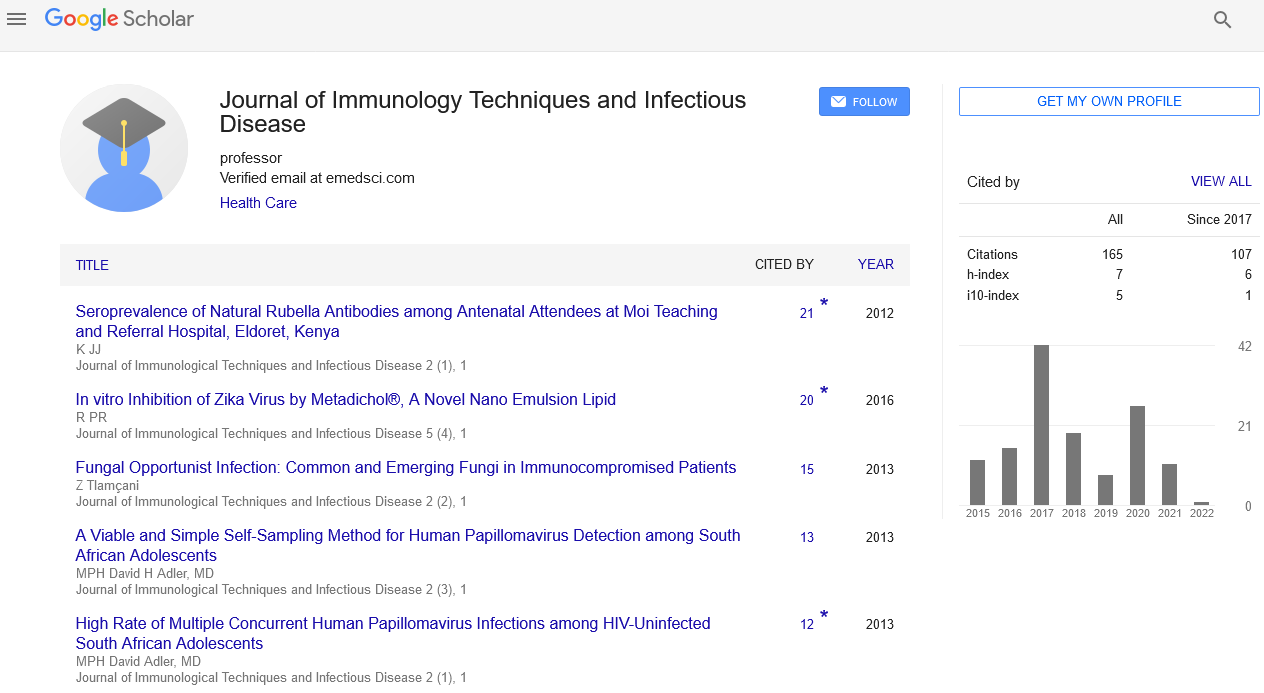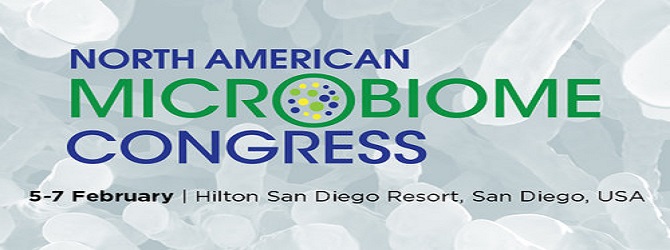Editorial, J Immunol Tech Infect Dis Vol: 9 Issue: 1
Immunological Techniques
Xia Jin*
Department of Medicine, Infectious Diseases ,University of Rochester Medical Center, New York, USA
*Corresponding Author : Xia Jin
Department of Medicine, Infectious Diseases, University of Rochester Medical Center, New York, USA
E-mail: xia_jin@urmc.rochester.edu
Citation: Xia Jin (2020) Immunological Techniques. J Immunol Tech Infect Dis 9:1. doi: 10.37532/jidit.2020.9(1).e103
Abstract
I am happy to introduce journal of Immunological Techniques and Infectious Diseases which is a peer reviewed academic journal (ISSN NO: 2329-9541) which aims to publish the articles that makes a significant contribution in advancing knowledge for immunological application in the treatment of various infectious diseases. The Journal includes all major themes pertaining to Immunity, Immunization techniques, Vaccination, Epidemology and treatment of infectious diseases. Some of the most articles cited are: • Investigation of a Rotavirus Gastroenteritis Outbreak among Immunosuppressed Patients in a Hospital Setting. • The Establishment of Realtime Fluorescent Quantitative Polymerase chain reaction (PCR) for Detection of Highly Pathogenic Avian Influenza Virus Subtype H5N1. • Fluorescence Microsphere Immunoassay for Detection of Antibodies to Porcine Reproductive and Respiratory Syndrome Virus and Porcine Circovirus type 2 using Protein A, Protein G, and Protein A/G. • Progression of Common Variable Immunodeficiency in Romanian Patients.
Keywords: Immunological techniques
Editorial
I am happy to introduce journal of Immunological Techniques and Infectious Diseases which is a peer reviewed academic journal (ISSN NO: 2329-9541) which aims to publish the articles that makes a significant contribution in advancing knowledge for immunological application in the treatment of various infectious diseases. The Journal includes all major themes pertaining to Immunity, Immunization techniques, Vaccination, Epidemology and treatment of infectious diseases.
Some of the most articles cited are:
• Investigation of a Rotavirus Gastroenteritis Outbreak among Immunosuppressed Patients in a Hospital Setting.
• The Establishment of Realtime Fluorescent Quantitative Polymerase chain reaction (PCR) for Detection of Highly Pathogenic Avian Influenza Virus Subtype H5N1.
• Fluorescence Microsphere Immunoassay for Detection of Antibodies to Porcine Reproductive and Respiratory Syndrome Virus and Porcine Circovirus type 2 using Protein A, Protein G, and Protein A/G.
• Progression of Common Variable Immunodeficiency in Romanian Patients.
Immunological techniques
Immunological techniques are the wide varieties of methods and specialized experimental protocols devised by immunologists for inducing, measuring, and characterizing immune responses.
Immunological techniques include both experimental methods to study the immune system and methods to generate or use immunological reagents as experimental tools. The most common immunological methods relate to the production and use of antibodies to detect specific proteins in biological samples.
They allow the immunologists to alter the immune system through cellular, molecular and genetic manipulation. These techniques are not restricted to the field of immunology , but are widely applied by basic scientists in many other biological disciplines and by clinicians in human and veterinary medicine.
Most immunological techniques available are focused on the study of the adaptive immune system. They classically involve the experimental induction of an immune response using methods based on vaccination protocols. During a typical experiment called immunization , immunologists inject a test antigen to an animal or human subject and monitor for the appearance of immune responses in the form of specific antibodies and effector T cells . Monitoring the antibody response usually involves the analysis of crude preparations of serum from the immunized subject. The analysis of the immune responses mediated by T cells are usually performed only on experimental animals and involves the preparation of these cells from blood or from the lymphoid organs, such as the spleen and the lymph nodes. Typically, any substance that has a distinctive structure or conformation that may be recognized by the immune system can serve as an antigen. A wide range of substances from simple chemicals like sugars, and small peptides to complex macromolecules and viruses can induce the immune system. Although the antigenic determinant of a test substance is usually a minor part of that substance called the epitope, a small antigen referred to as a hapten can rarely elicit an immune response on its own. It is not an immunogen and would therefore need to be covalently linked to a carrier in order to elicit an immune response. The induction of such a response to even large immunogenic antigen is not easy to achieve and the dose, the form and route of administration of that antigen can profoundly affect whether a response can occur. Especially the use of certain substances called adjuvants is necessary to alert the immune system and produce a strong immune response.
According to the clonal selection theory, antibodies produced in a typical immunization experiment are products of different clones of Blymphocytes that are already committed to making antibodies to the corresponding antigen. These polyclonal antibodies are multi-subunit proteins that belong to the immunoglobulins family. They have a basic Y-shaped structure with two identical Fab domains, which form the arms and interact with the antigen, and one Fc domain that forms the stem and determines the isotype subclass of each antibody. There are five different isotype subclasses, IgM, Ig G, IgA, IgE, and IgD, which show different tissue distribution and half-life in vivo. They determine the biological function of the antibodies and appear during different stages of the immunization process. Knowledge about the biosynthesis and structure of these antibodies is important for their detection and use both as diagnostic and therapeutic tools.
Antibodies are highly specific for their corresponding antigen, and are able to detect one molecule of a protein antigen out of around a billion similar molecules. The amount and specificity of an antibody in a test serum can be measured by its direct binding to the antigen in assays usually referred to as primary interaction immunoassays. Commonly used direct assays are radioimmunoassay (RIA), enzymelinked immunosorbent assay (ELISA ), and immunoblotting techniques. In both ELISA and RIA, an enzyme or a radioisotope is covalently linked to the pure antigen or antibody. The unlabeled component, which most often is the antigen, is attached to the surface of a plastic well. The labeled antibody is allowed to bind to the unlabeled antigen. The plastic well is subsequently washed with plenty of buffer that will remove any excess non-bound antibody and prevent non-specific binding. Antibody binding is measured as the amount of radioactivity retained by the coated wells in radioimmunoassay or as fluorescence emitted by the product of an enzymatic reaction in the case of ELISA. Modifications of these assays known as competitive inhibition assays can be used that will allow quantifying the antigen (or antibody) in a mixture and determining the affinity of the antibodyantigen interaction by using mathematical models. Immunoblotting is usually performed in the form of Western blotting, which is reserved to the detection of proteins and involves an electrophoresis separation step followed by electroblotting of the separated proteins from the gel to a membrane and then probing with an antibody. Detection of the antigen protein antibody interaction is made in a similar way as in RIA or ELISA depending on whether a radiolabeled or enzyme-coupled antibody is used.
Antibodies can also be monitored through immunoassays that are based on the ability of antibodies to alter the physical state of their corresponding antigens and typically involve the creation of a precipitate in a solid or liquid medium. The hemmaglutination assay used to determine the ABO type of blood groups and match compatible donors and recipients for blood transfusion is based on this assay. Currently, the most common application of this immunoassay is in a procedure known as immunoprecipitation. This method allows antibodies to form complexes with their antigen in a complex mixture like the cytosol, the nucleus or membrane complexes of the cell. The antigen-antibody complex is precipitated either by inducing the formation of even larger complexes through the addition of excess amounts of anti-immunoglobulin antibodies or by the addition of agarose beads coupled to a special class of bacterial proteins that bind the Fc region of the antibody. The complex can also be precipitated by covalently linking the antibody to agarose beads forming a special affinity matrix. This procedure will also allow the purification of the antigen by immunoaffinity, a special form of affinity chromatography. Immunoprecipitation is a valuable technique that led to major discoveries in immunology an all disciplines of molecular and cellular biology. It allows the precipitation of the antigen in complex with other interacting proteins and reagents and therefore gives an idea on the function of the antigen.
The T cell immune response is detected by using monoclonal antibodies, a specific family of antibodies that recognize surface markers that are expressed by lymphocytes upon their activation. These monoclonal antibodies are highly specific, and are produced by special techniques from single clones of B cells and are therefore, homogenous groups of immunoglobulins with the same isotype and antigen binding affinity. These antibodies are used to identify characterize cells by flow cytometry (FACS), immunocytochemistry, immunofluorescence techniques. The difficulty to isolate antigen specific T cells is due to the fact that these T cells recognize the antigen in the context of a tri-molecular complex involving the T cell receptor and the MHC molecules on the surface of specialized cells called antigen-presenting cells. These interactions are subtle, have low affinity and are extremely complex to study. Novel and powerful techniques using tetramers of MHC molecules were developed in 1997 that are now used to identify and isolate antigen specific T cell clones. These tetramer-based assays are proving useful in separating very rare cells, and could be used in clinical medicine. In fact, virus and tumor specific T cells usually give a stronger response and are usually more effective in killing virus infected and tumor cells. Testing for the function of activated, antigen specific T cells known as effector T cells is routinely done in vitro by testing for cytokine production, cytotoxicity to other cells and proliferation in response to antigen stimulation. Local reactions in the skin of animals and humans provide information about T cell responses to an antigen, a procedure that is very used in testing for allergic reactions and the efficacy of vaccination procedures. Experimental manipulations of the immune system in vivo are performed to reveal the functions of each component of the immune system in vivo. Mutations through irradiation, or mutations produced by gene targeting (e.g., knock-out and knock-in techniques), as well as animal models produced by transgenic breeding, are proving helpful to researchers in evaluating this highly complex system.
 Spanish
Spanish  Chinese
Chinese  Russian
Russian  German
German  French
French  Japanese
Japanese  Portuguese
Portuguese  Hindi
Hindi 
